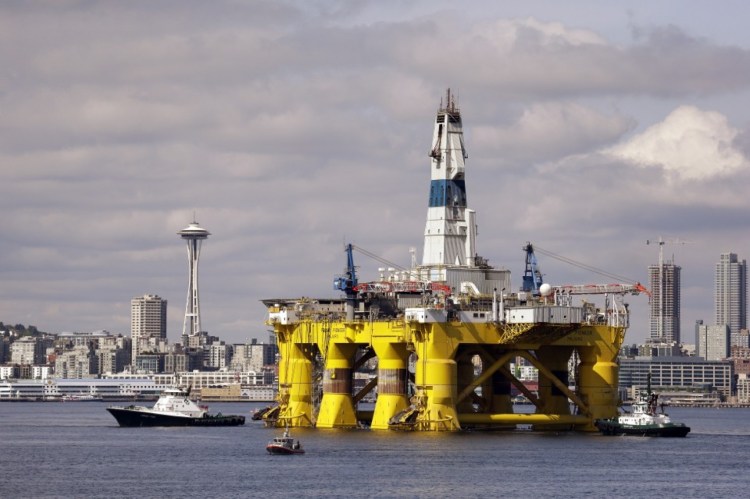WASHINGTON — The Obama administration on Friday banned offshore drilling in the Arctic, setting a likely collision course with President-elect Donald Trump, who has vowed to “unleash” new energy production in the United States by rolling back restrictions on oil and gas companies.
The move by the Interior Department, part of a new five-year plan for energy development in federal waters, would put a temporary end to exploration in the Chukchi and Beaufort Seas off the Alaskan coast. It also dropped plans to allow companies to drill for oil and natural gas in the Atlantic Ocean off of four southeastern states, including Virginia.
“The plan focuses on lease sales in the best places – those with highest resource potential, lowest conflict, and established infrastructure – and removes regions that are simply not right to lease,” Interior Secretary Sally Jewell said in a statement Friday. “Given the unique and challenging Arctic environment and industry’s declining interest in the area, forgoing lease sales in the Arctic is the right path forward.”
The areas off Alaska currently are considered by big oil companies to be too expensive to explore given low crude prices, the steep expenses of drilling in icy waters and the costly failure by Royal Dutch Shell to discover oil in 2015 after years of preparation. Shell spent more than $7 billion, and in the end the hole it drilled was virtually dry.
Even if the economics of Arctic drilling improve and a Trump administration wants to reopen the area to exploration, both oil company officials and environmental groups say, Trump would be unable to toss out the five-year plan immediately. To undo the Obama administration’s ban, a new administration would have to prepare a supplemental report, which could take as long as two years, depending on whether it needs to prepare a new environmental impact statement.
After that, the federal government would have to organize a lease sale for companies interested in drilling there.
Environmental groups were quick to praise the Obama administration’s action on Friday, even as they argued that there should be a permanent ban on Arctic drilling.
Jacqueline Savitz, a senior vice president for the marine-advocacy group Oceana, said the decision “demonstrates a commitment to prioritizing common sense, economics and science ahead of industry favoritism and politics as usual.” She added, “The decades-long push to drill in the Arctic has put this unique and diverse ecosystem at risk, cost tens of billions of dollars and created significant controversy without providing the promised benefits.”
Lois Epstein, an Alaska-licensed engineer and Arctic program director for the Wilderness Society, also praised the decision.
“Arctic Ocean oil is among the riskiest and most costly in the world and producing it will worsen the effects of climate change,” she said. “Additionally this oil is not needed because there likely will be ample world oil supply available for many years, and the trans-Alaska pipeline system has enough oil throughput to operate for the next half-century.”
Meanwhile, representatives of the oil and gas industry called the decision a short-sighted one that could cost American jobs.
“Our national energy security depends on our ability to produce oil and natural gas here in the U.S., and this decision could very well increase the cost of energy for American consumers and close the door on creating new jobs and new investments for years,” said Jack Gerard, president of the American Petroleum Institute. “We are hopeful the incoming administration will reverse this decision.”
The Interior Department on Friday said that in crafting the five-year oil-and-gas leasing plan, it had considered 3.3 million public comments and held three dozen public meetings. The final plan, which will dictate offshore drilling through 2022, offers 11 potential leases for sale off the nation’s coasts. Ten of those are in the Gulf of Mexico, and one is off the coast of Alaska in the Cook Inlet area, near Anchorage.
“The proposal makes available more than 70 percent of the economically recoverable resources, which is ample opportunity for oil and gas development to meet the nation’s energy needs,” Abigail Hopper, director of the Bureau of Ocean Energy Management, said in announcing the plan Friday.
If the federal government ever does reopen the Arctic to drilling, one company that might be interested is Caelus, a privately held, Dallas-based firm that has found new reserves of oil in the Oooguruk field on the North Slope of Alaska in state waters. If the field stretches beyond the three-mile limit of state waters, Caelus would need a federal lease to tap those reserves.
Environmental groups are also worried about a possible push by the Trump administration to open up the Alaska Natural Wildlife Refuge, a vast area of northeastern Alaska that so far has been off limits to oil and gas companies. Sen. Lisa Murkowski (R-Alaska) has been a persistent advocate of opening up the refuge, but other lawmakers, including Sen. John McCain (R-Ariz.) have favored protecting the area.
Opening up the refuge to drilling would require legislation in Congress.
The state of Alaska has been watching all this carefully, in part because new supplies of petroleum would help fill both the state’s coffers and the Trans-Alaska Pipeline System, which is logistically challenged by a decline in crude oil production in Prudhoe Bay on Alaska’s north coast. Production at Prudhoe Bay, the largest oil field in North America and among the 20 largest fields in the world, peaked in 1987 and has dropped sharply in recent years.
The U.S. Geological Survey in 1998 estimated that there could be as much as 5.7 billion to 16 billion barrels of technically recoverable oil within Alaska Natural Wildlife Refuge, including state and Native American areas.
Send questions/comments to the editors.



Comments are no longer available on this story